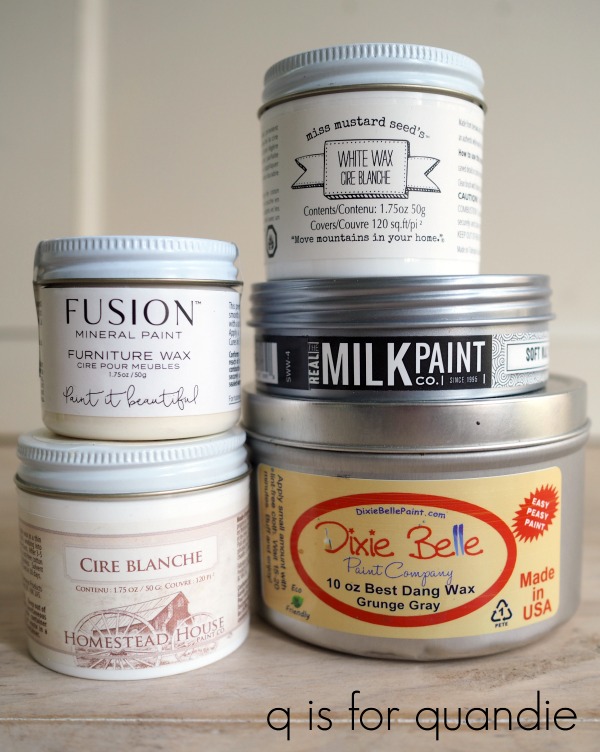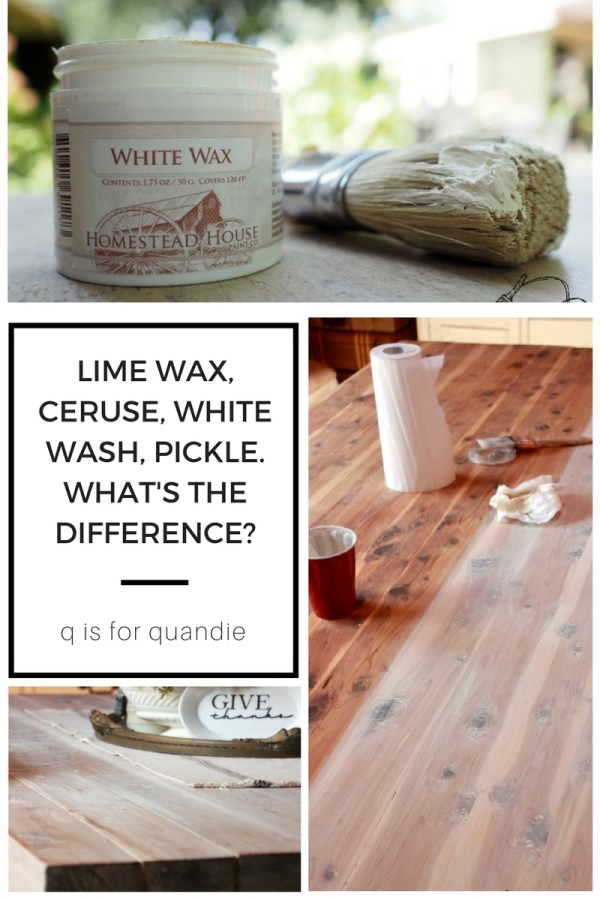On Monday I shared my favorite technique for using a dark wax over bare wood. Today I thought I’d focus on using other colors of wax over bare wood (or white washed wood).

Once again, all of my favorite wax brands make a version of white wax.

Starting at the top and moving clockwise that’s Miss Mustard Seed White Wax, Homestead House White Wax, the Real Milk Paint Co Soft White Wax, and Fusion Liming Wax.
That brings up the first question, are white wax and liming wax the same thing?
I don’t have a definitive answer from the experts, but I’m pretty sure they can be used interchangeably. One may have a slightly different color, or maybe a little more or less pigment, but as you can see all of the white waxes that I have are slightly different in color anyway.

You can apply white wax to bare wood in just the same way as the dark waxes that I talked about on Monday. If you need a refresher you can refer back to that post. However, I often choose to apply a coat of clear wax before applying the white. The purpose of that is to soften the look of the white wax and allow it to blend a little bit more. But if you want that cerused or lime waxed look to be more pronounced and you really want to see those streaks of white that catch in the grain of your wood, go ahead and just use the white wax right over your bare wood.
The tabletop below has a coat of clear wax followed by a coat of white wax.

As does the top of this washstand.

These days I almost always apply my wax with a brush and then remove any excess wax with an old t-shirt. The large Miss Mustard Seed wax brush is a favorite of mine (you can find it online at Carver Junk Co if you need one). Mine is well used …

Another favorite light wax of mine is grey wax. I used to make my own grey wax by mixing black and white wax together.

But now when I want grey wax I just use Dixie Belle’s Best Dang Wax in Grunge Grey.

I used this wax on a coffee table last winter.

It gives that sort of driftwood appearance.
Finally, there is always the option of just using a clear furniture wax over bare wood. That’s what I did on this buffet top.

Just keep in mind that clear wax won’t alter the color of your wood like the tinted waxes will, it also won’t help blend any discolorations that your wood might have.
But if you love the natural color of the wood on your piece, try just using clear wax.
Before I let you go I want to mention that besides being an incredibly easy and relatively foolproof technique to use, I think wax provides the most natural looking finish for beautiful wood.

It isn’t the most impervious finish, nor is it the shiniest. If you’re looking for a perfect looking finish, maybe wax isn’t for you.
But if you like to embrace the imperfections in old furniture and bring them back to life just a bit, definitely give this a try!
Also, if you’d like to learn more about lime waxing or white washing, check out this post …



Thank you for all the good information! I have never used white wax. I want to try and use it on a beachy type piece of furniture. Maybe a blue painted piece with a natural top and white wax the whole piece. I live on an island so I am going to give it a try. 😊
LikeLike
Love that idea, and how awesome that you live on an island!! I’m jealous.
LikeLike
Q, my kitchen cabinets have a white/dark wax finish that the builder did 7 years ago when we bought the house. They have yellowed somewhat and, while I don’t want to paint them, I might like to do a white wax or white dry brush effect to lighten them up. Asking for advice…would any of the waxes you discussed be good for that? Thanks in advance for any advice you might have.
LikeLike
It’s hard for me to say since I’ve never tried something like that myself and I don’t know specifically what products were used on your cabinets. But it certainly would be worth a try. And I think any of the waxes I’ve shown would work. First off, since wax is meant to be reapplied periodically, your cabinets definitely might be in need up a fresh coat of wax. Second, since you are working with a surface that is already waxed you shouldn’t have any adverse affect from applying more wax that I can think of. If I were you, I’d try it on a small test spot and see how it looks first and then go from there. Be sure to clean them well first and then give it a go.
LikeLike
Thanks so much for your advice. I’ll try it on a cabinet that’s in an area where I could hide it if needed. Will let you know how it worked out and will try to get some good photos before and after.
LikeLike
Sounds like a plan Sugar!
LikeLike
Hey Miss Quandie! Thank you for these informative and detailed posts…….they really do make up a good reference library! I’ll will be missing your posts when you’re off on your trip!
LikeLike
Awww, thanks Constance! Initially I was thinking about scheduling some posts in advance for my vacation, but that never happened and now I’m running out of time. So you may have to suffer from a little withdrawal over the next two weeks while I am gone 😉
LikeLike
Another incredibly informative post. I never thought of using white or liming wax. Another tidbit to add to my arsenal of things to do. Thank you! All your dresser and tabletops are beautiful. You’ve definitely steered me away from staining which has been a chore for me since my 4th project. My first 3 projects were easy and went smoothly then I read about what could happen – splotches, unevenness, etc – and then the bad stuff started happening. Why does that happen? When your new and naive to the problems that can arise everything goes smoothly but as soon as you learn about what can happen, BAM – there it is! This is the perfect and most beautiful solution. And, if you use a water-based wax you could protect with a poly if you wanted the added protection.
LikeLike
LOL, yes, that is how it goes isn’t it? Once you realize all the stuff that can go wrong, suddenly it does!
LikeLike
Thanks for more great info! I painted a tray in FAT navy chalk paint and applied white wax directly over and was pleased with the “denim” look it created. Enjoy your trip-you will be missed.
LikeLike
That sounds like a fun effect, I might have to give that a try myself!
LikeLike